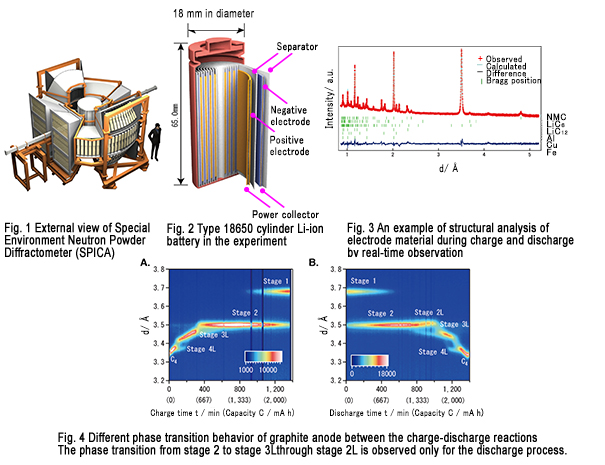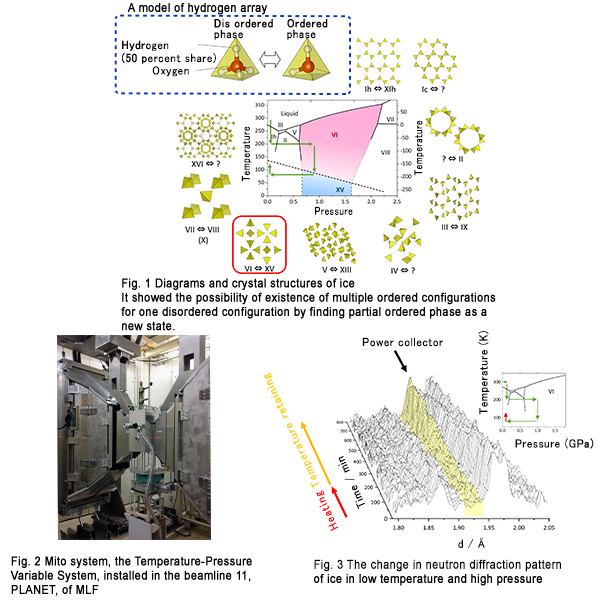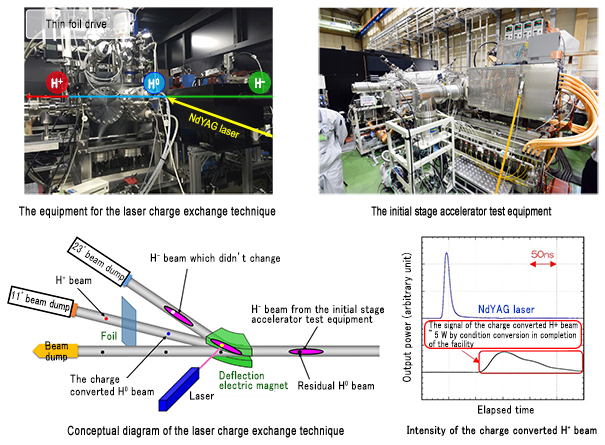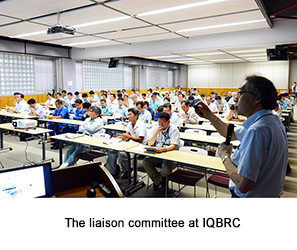| ■ J-PARC News - July 2016 (Issue #135) |
| ● Lecture by Professor Takaaki Kajita Commemorating his Nobel Prize in Physics "Neutrinos : The Link Between Space and Elementary Particles" (July 16, Tokai Culture Center) |
|---|
| On July 16, the J-PARC Center and Tokai Village jointly held a lecture meeting at the Tokai Culture Center featuring Takaaki Kajita, Director of the Institute for Cosmic Ray Research, University of Tokyo, and winner of the 2015 Nobel Prize in Physics. There were about 700 participants, ranging from elementary and junior high school students to adults, most from Tokai Village but also from outside the prefecture. The event was moderated by Hiromi Yokoyama, Associate Professor at the University of Tokyo, whose specialty is science communication. To kick-off the event, Hitoshi Murayama, Director of the Kavli Institute for the Physics and Mathematics of the Universe, University of Tokyo, gave a talk entitled "Our Father, the Neutrino." He explained, in an easy-to-understand way, that the neutrino is an elementary particle that has had major effects on space and our existence. Next, Professor Kajita spoke on the topic "Neutrinos : The Link Between Space and Elementary Particles." While showing photos going back to his student days, he talked about his research career leading up to winning the Nobel Prize, and the future of neutrino research. After the lectures, there were many questions from the audience, and the two professors politely answered each one. The second part was a mingling session, and Professors Kajita and Murayama were joined by researchers involved with J-PARC and the T2K (Tokai to Kamioka) experiment. The group responded to questions and doubts from students representing elementary schools in the village, and from participants at the venue. There were many points where the hall grew excited at the wide-ranging, enthusiastic questions, and the answers revealing each professor's character. The meeting was a great success. |
|
| ● Successful Analysis of the Internal Behavior of Charging and Discharging Lithium Ion Batteries (June 30, Press Release) - Non-Destructive, Real-Time Observation using Neutron Beams - |
|---|
| A research group comprised of Researcher Sou Taminato and Professor Ryoji Kanno of the Tokyo Institute of Technology, Designated Associate Professor Masao Yonemura and Professor Takashi Kamiyama of the High Energy Accelerator Research Organization (KEK) (Neutron Science Section, J-PARC Center), and Associate Professor Kazuhiro Mori, Professor Toshiharu Fukunaga, Designated Professor Hajime Arai, Designated Professor Yoshio Ukyo, Professor Yoshiharu Uchimoto, and Specially-Appointed Professor Zempachi Ogumi of Kyoto University, et al., has used the Special Environment Neutron Powder Diffractometer (SPICA : BL09) * and a newly developed data analysis system to successfully analyze, at the atomic level, complex structural changes of materials which occur inside lithium ion batteries during actual charging and discharging. This technique enabling real-time observation and analysis of battery reactions-which change from moment to moment-allows easy acquisition of detailed information relating to reliability and safety of storage batteries, and is expected to make a major contribution not only to further improvement of performance, but also to development of next-generation storage batteries such as all-solid batteries. These results were achieved through joint research with the New Energy and Industrial Technology Development Organization (NEDO), and were featured in the June 30 issue of the British science journal Scientific Reports. |
| * This instrument was developed based on the Research & Development Initiative for Scientific Innovation of New Generation Batteries (RISING), and is installed in the MLF. |

 * Click here to enlarge. * Click here to enlarge. |
| |
| ▲to Page Top |
| |
|
| ● Discovery of a New Ordered State in High-Pressure Ice - Solving One of the Five Great Unsolved Problems of Ice - (July 4, Press Release) |
|---|
| The familiar substance of ice is known to assume various crystal structures depending on temperature and pressure. Regarding the ice XV phase formed at low temperature and high pressure (roughly an absolute temperature of 50K, and pressure of 10,000 atmospheres), there is a discrepancy in that its properties cannot be explained with previously advocated models, and this is one of the five great unsolved problems of ice research. A research group led by Associate Professor Kazuki Komatsu and Professor Hiroyuki Kagi of the Graduate School of Science, the University of Tokyo developed equipment (commonly known as the "Mito system") enabling free adjustment of pressure even at low temperature. Working in collaboration with associate principal researcher Asami Sano and Principal researcher Takanori Hattori of the Japan Atomic Energy Agency (Neutron Science Section, J-PARC Center), and Researcher Shinichi Machida of the Neutron Science and Technology Center, Comprehensive Research Organization for Science and Society (CROSS), they introduced the High Pressure Neutron Diffractometer (PLANET) of the Materials and Life Science Experimental Facility (MLF), and succeeded in in-situ observation of neutrons of the ice XV phase at low temperature and high pressure. As a result, it was shown that the ice structure is a partially ordered state which differs from the ordered state in which hydrogen is biased in one direction in the oxygen framework structure, and the unordered phase which is completely random. For this reason, it was proposed that the same principle also applies to other types of ice with different oxygen framework structures. They are not divided only into an ordered phase and unordered phase, and a partially ordered state must also be considered. |
| |

 * Click here to enlarge. * Click here to enlarge. |
| |
| ▲to Page Top |
| |
|
| ● Successful Laser Charge Conversion Testing of 3MeV Beam from Initial Stage Accelerator (June 28, Linac Building) |
|---|
| J-PARC is considering construction of a Transmutation Experimental Facility (TEF), and in the future at this facility, a negative hydrogen ion (H-) beam from the Linac will be irradiated with laser light to strip off electrons and convert to an H0 beam, and then another electron will be stripped off with charge conversion foil to extract the final H+ beam (max. 10 W). Various instruments have previously been prepared in the klystron preparation room of the Linac Building, such as the charge conversion system for laser charge conversion demonstration testing, and initial stage accelerator test equipment. On June 28, charge conversion testing was successfully completed using a 3MeV beam from the initial stage accelerator, and an H+ beam was extracted to the 11-degree dump. When the intensity of the charge converted H+ beam is converted to conditions at completion of the facility, the figure is approximately 5 W, and this roughly meets the output requirements (max. 10 W). |
| |

 * Click here to enlarge. * Click here to enlarge. |
| |
| ▲to Page Top |
| |
|
| ● 12th Collaboration Meeting on Muon g-2/EDM (June 29 - July 2, J-PARC Research Building) |
|---|
| A collaboration meeting on muon g-2/EDM was held at the J-PARC Research Building, with the participation of about 65 researchers from Japan, Canada, and three countries in Asia. In terms of projects relating to J-PARC discussed at the KEK-PIP Advisory Committee* in May of this year, the meeting confirmed H line construction and a g-2/EDM experiment plan for the muon facility. The meeting opened with a greeting by Naohito Saito, Director of the J-PARC Center. Then there were reports and exchanges of views by the people involved regarding plans for precision measurement of muon g-2/EDM (anomalous magnetic moment/electric dipole moment) using ultra-cold muon beams. There was also an introduction to and tour of the construction situation of the H line at the Muon Experimental Facility of the MLF. |
| * Advisory meeting for obtaining KEK's advice on the project implementation plan |

 * Click here to enlarge. * Click here to enlarge. |
| |
| ▲to Page Top |
| |
|
| ● 2nd Liaison Committee on Safety and Health for Contractors at J-PARC (July 6, Ibaraki Quantum Beam Research Center (IQBRC)) |
|---|
| Liaison committee meetings were started last year to allow J-PARC staff, yearly contractors and others doing work at J-PARC to share a safety mindset of "ensuring safety in all work." This time, there were 74 participants from 66 companies. Tetsuro Ishii, Deputy Director (Safety) provided an overview of J-PARC and discussed recent research results. Then he reported on recent accidents and trouble at J-PARC, gave precautions for work, and explained a new effort, the "Mindful of Others : Speak out, if you find an act of danger" campaign. In the exchange of views at the end, participants expressed the need for measures to deal with tunnels and other work environments where ordinary communication with mobile phones functions poorly. |
| |

 * Click here to enlarge. * Click here to enlarge. |
| |
| ▲to Page Top |
| |
|
| ● J-PARC Hello Science (June 22, Muramatsu Elementary School, July 7, Shirakata Elementary School, Tokai Village) |
|---|
| In June and July, the J-PARC Center held J-PARC Hello Science events for the science clubs of two elementary schools in Tokai Village, and students were introduced to the amazing world of batteries and magnets. At the event at Shirakata Elementary School, the teacher supervising the experiment had a favorable impression : "This is an experiment that can't be done by the children alone (... We'd like you to do it again next year...)." The students participated in hands-on experiments. The "running battery" in which a battery with magnet attached runs through a coil of copper wire, was once again very popular. While demonstrating with a "hand-operated motor," in which the direction of current flowing into the coil is switched with just the right timing, the instructor explained, in an easy-to-understand way, the operating principle of a motor-how it rotates by exploiting the forces of attraction and repulsion acting between a permanent magnet and an electromagnet. The children also observed with great curiosity a model of a Faraday motor, said to be the first motor ever built in the world. We hope these activities will lead more children to love science. |
| |

 * Click here to enlarge. * Click here to enlarge. |
| |
| ▲to Page Top |
| |
|
| ● TIA Flower Arrangement Class (July 7, Nuclear Science Research Institute) |
|---|
| A flower arrangement class, jointly organized with the Tokai-mura International Association (TIA) and others, was held at the Advanced Science Research Center of the Nuclear Science Research Institute. In this class, students used flowers such as lilies, roses, gladioluses, curcumas and cockscombs, and under the guidance of the instructor, created arrangements while imagining their finished piece-inserting the main branch (shushi), object branch (kyakushi), and fillers (chukanshi) into a pinholder. The 11 participants created refreshing works expressing early summer, appreciated each other's works, and carefully brought them back to their workplaces as decorations. |
| |

 * Click here to enlarge. * Click here to enlarge. |
| |
| ▲to Page Top |
| |
|
©2016 J-PARC Center. All rights reserved.
|
|